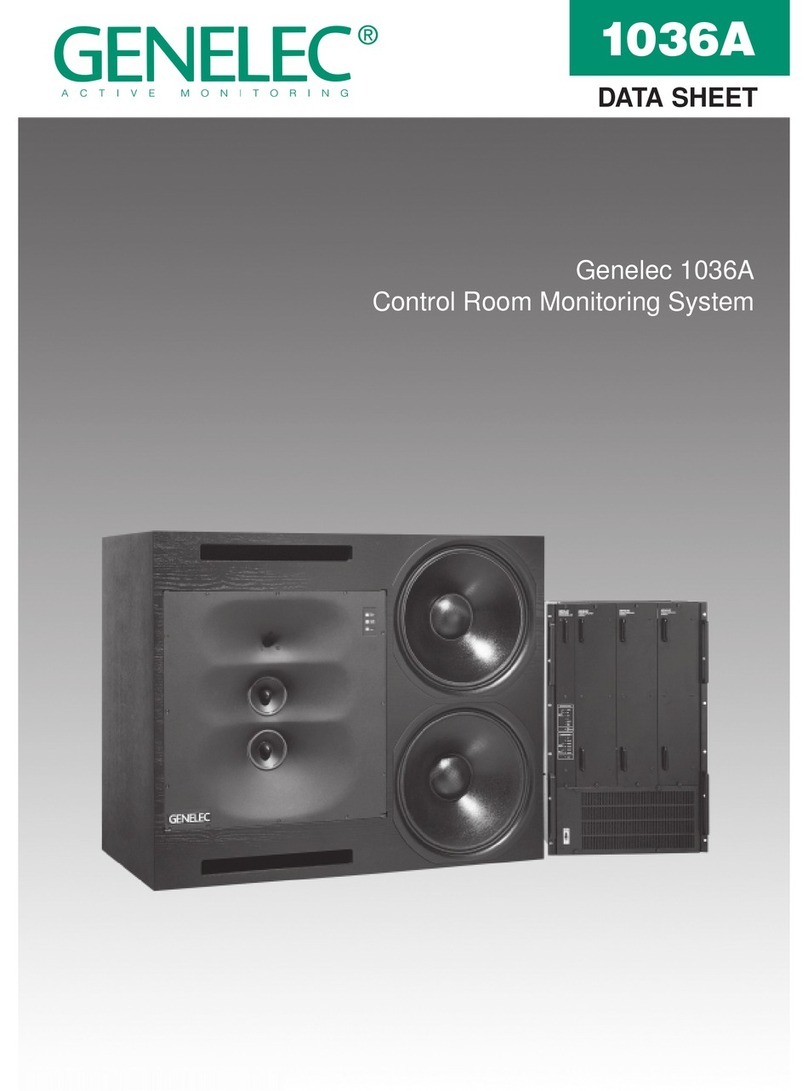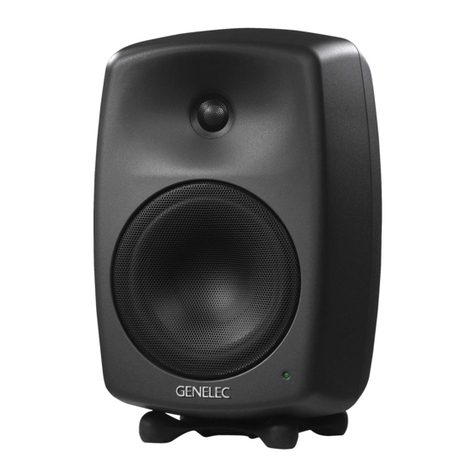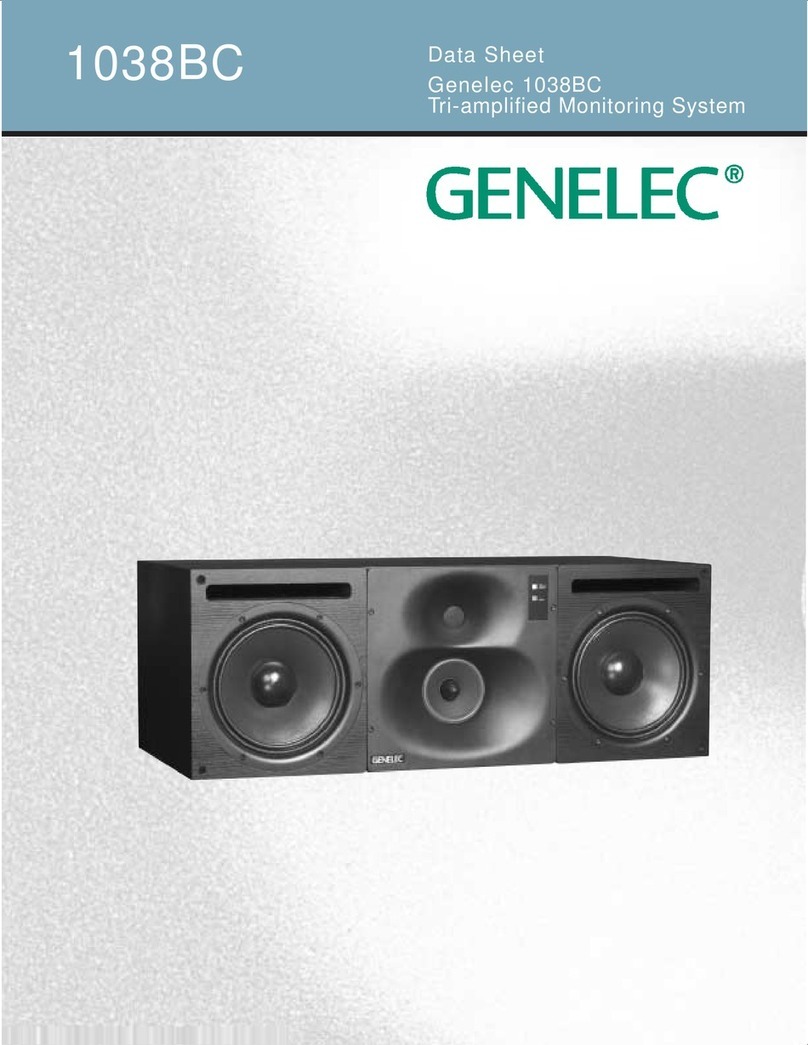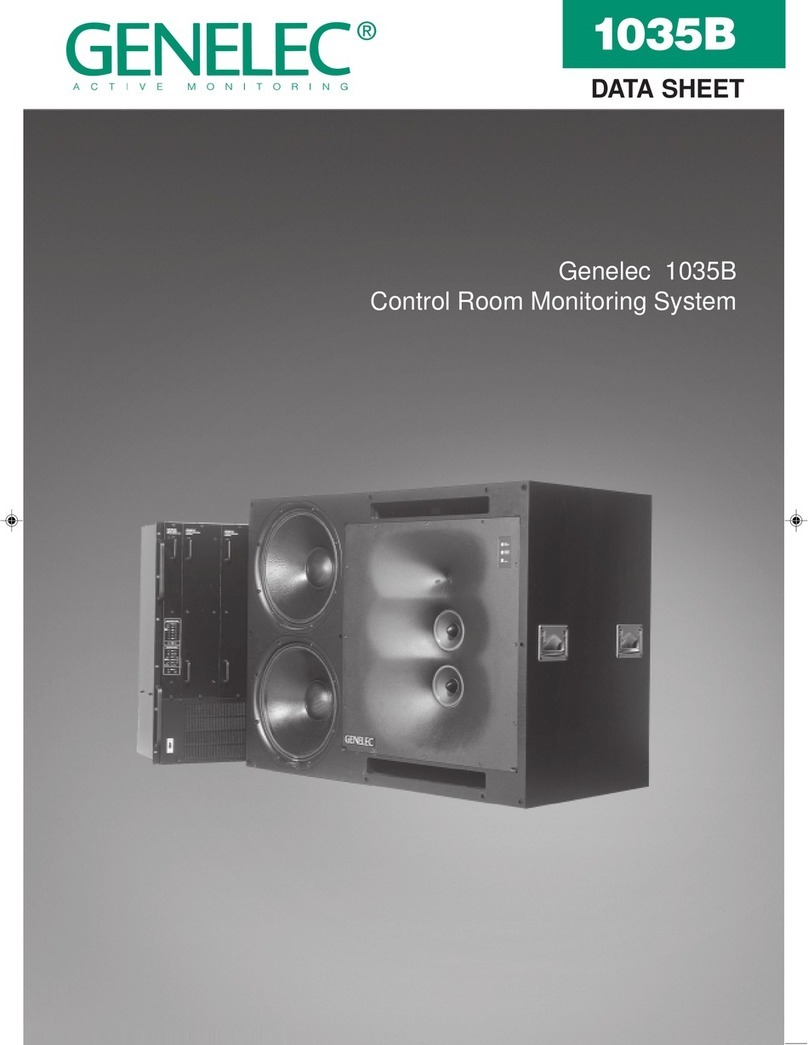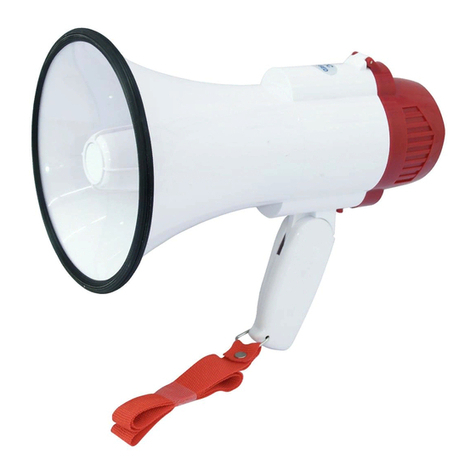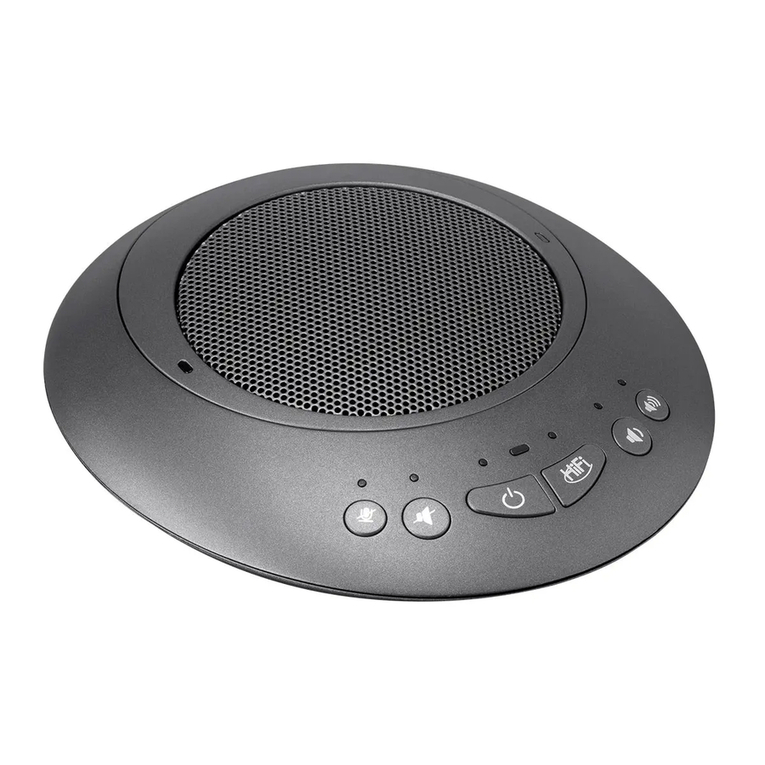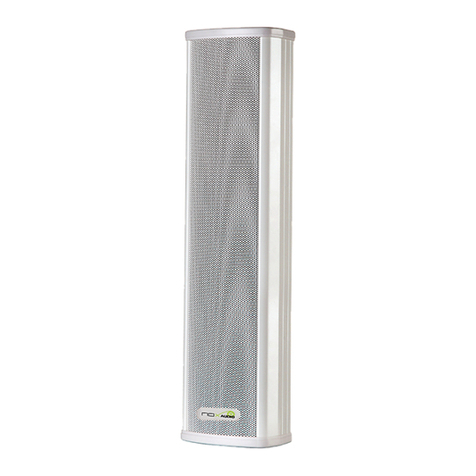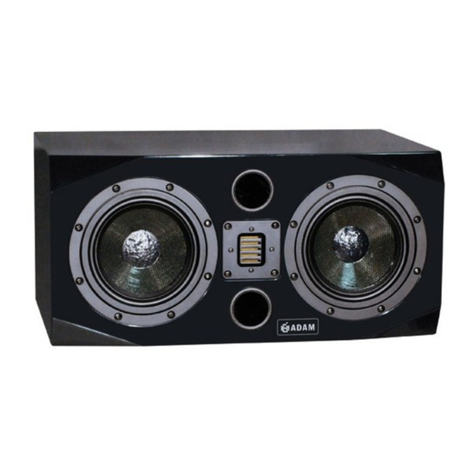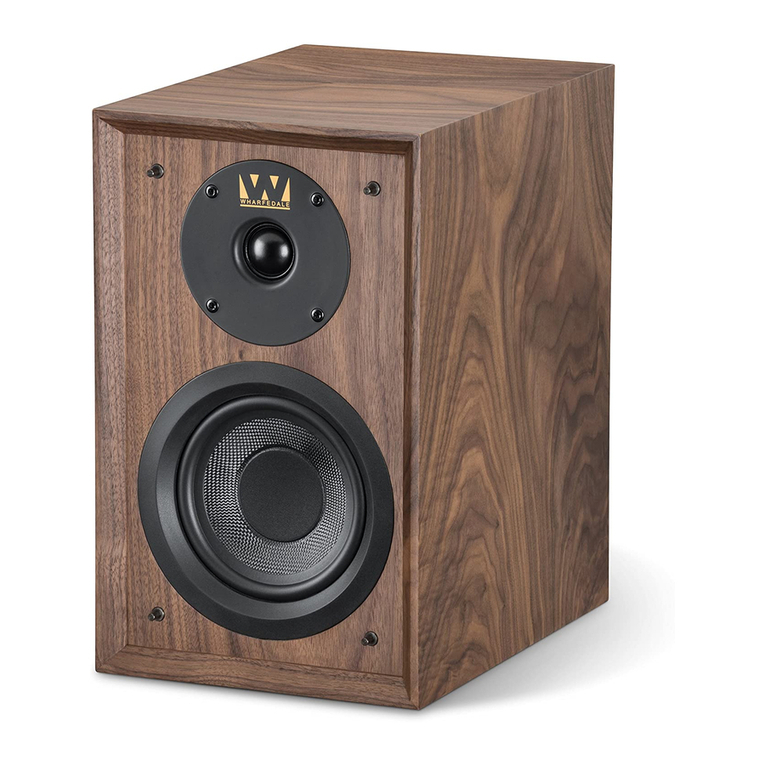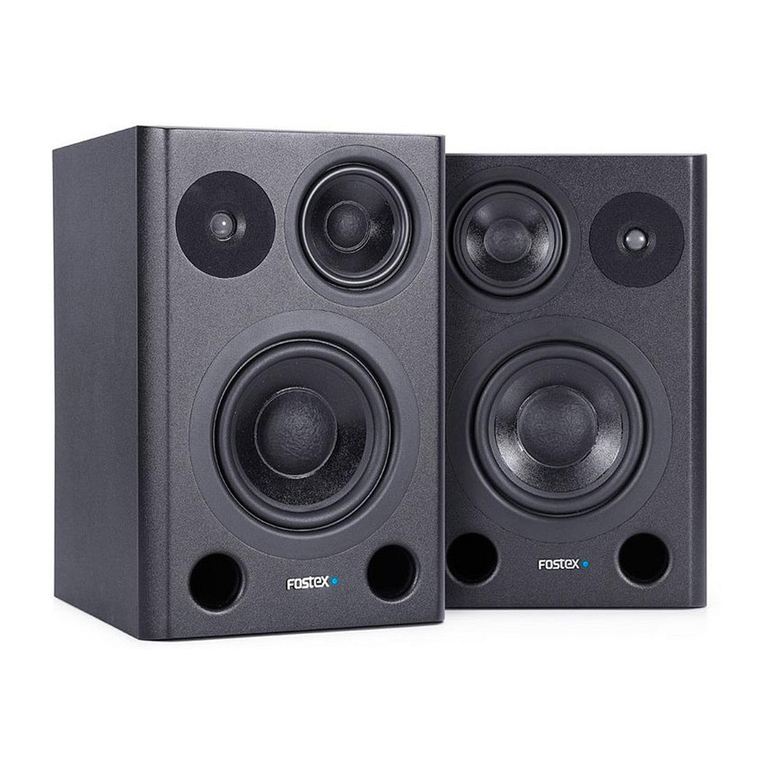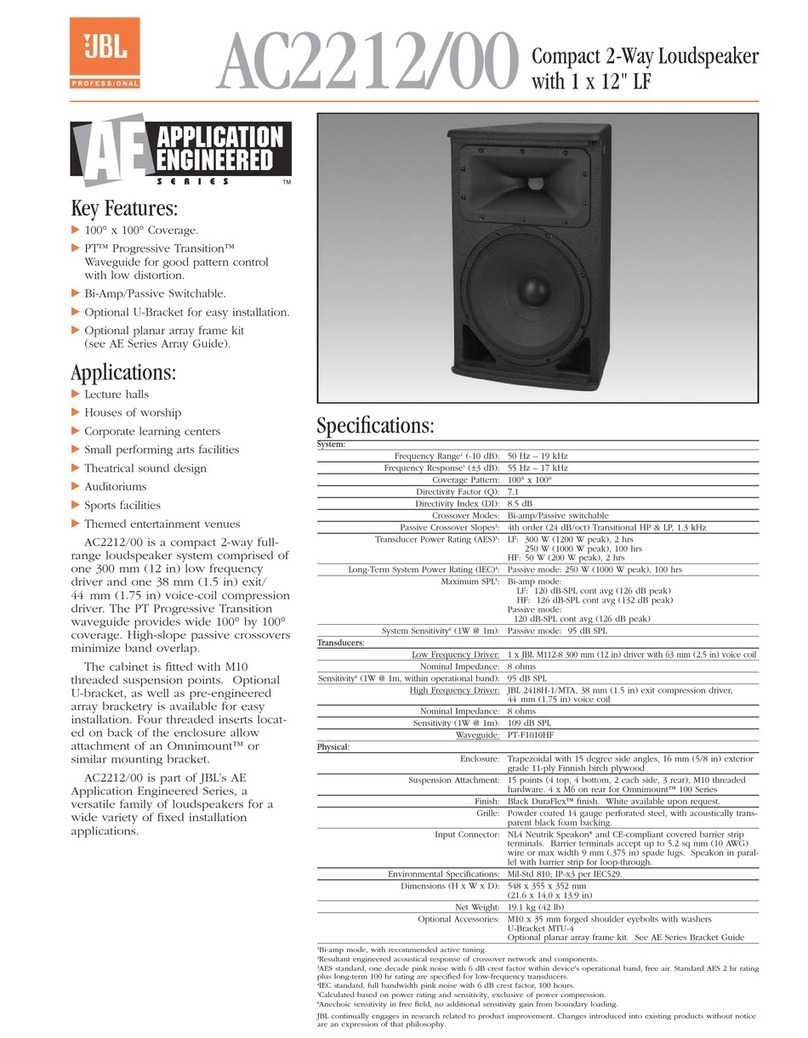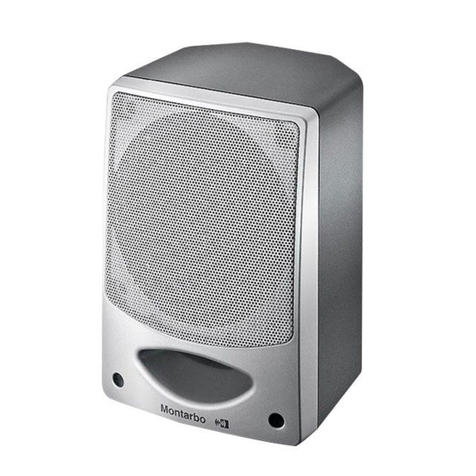Genelec 4040A User manual

Genelec 4040A
Active Loudspeaker
Operating Manual
4040A

General
The bi-amplified Genelec 4040A is a power-
ful but compact two way active loudspeaker
designed for fixed installations. As an active
loudspeaker, it contains drivers, power ampli-
fiers, active crossover filters and protection
circuitry. The 4040A is designed for indoor
use only, in temperatures between 15 to
35 degrees Celsius and relative humidity
between 20 % and 90 %.
The MDE™ (Minimum Diffraction Enclo-
sure™) loudspeaker enclosure is made
of die-cast aluminium and shaped to
reduce edge diffraction. Combined with the
advanced Directivity Control WaveguideTM
(DCWTM), this design provides excellent fre-
quency balance in difficult acoustic environ-
ments.
Positioning The Loudspeaker
Each 4040A is supplied with an integrated
amplifier unit, mains cable, a 5-pin connec-
tor for audio signal and 12 V trigger voltage,
a keyhole type wallmount and an operating
manual. After unpacking, place the loud-
speaker in its required listening position,
taking note of the line of the acoustic axis.
The axis should be pointed towards the
center of the listening area.
Connections
Before connecting up, ensure that the loud-
speakers and the signal source have been
switched off. The power switch of the 4040A
is located on the back panel (see Figure
3). Connect the loudspeaker to an earthed
mains connection with the supplied mains
cable. Never connect the loudspeaker to
an unearthed mains supply or using an
unearthed mains cable. Audio input is via
a 10 kOhm balanced Phoenix connec-
tor. The connector also has two pins for 12
V trigger voltage for power switching. The
pin sequence of the connector is shown in
Figure 2.
Connect the signal cable and 12 V trigger
voltage to the 5-pole plug provided with the
loudspeaker and secure the connections by
tightening the screws on each pole. Push the
plug into the connector on the loudspeaker.
Never connect the 4040A to the loud-
speaker outputs of a power amplifier or an
integrated amplifier or receiver.
Once the connections have been made,
the loudspeaker is ready to be switched on.
Controls
Level Control
The input sensitivity of the loudspeaker can
be matched to the output of the signal source
by adjusting the rotary level control on the
rear panel.
Autostart Sensitivity
This control sets the triggering sensitivity of
the signal sensing Autostart function. In case
of a high background noise level in the audio
network, the automatic shutoff may not func-
tion as the circuit detects the noise and mis-
interprets it as a valid signal. Switching the
“Autostart Sensitivity” switch to “ON” reduces
the triggering sensitivity and gives better
immunity to noise in the signal network. On
the other hand, if a very low playback level
is desirable, the Autostart function works
better in the more sensitive “OFF” setting.
The required triggering voltages are approxi-
mately 0.4 mV (OFF) and 1.4 mV (ON).
Autostart Off Time
This control sets the shutoff delay of the
Autostart function. When the switch is set to
“OFF”, the loudspeaker shuts off one hour
after ending the playback. In the “ON” setting,
the delay is 15 minutes.
Led Off
This switch turns off the green power indica-
tor LED. However, the overload indication by
red coloured LED remains active.
Tone Controls
The frequency response of the Genelec
4040A can be adjusted to match the acous-
tic environment by setting the tone control
switches on the rear panel. The controls
are “Bass Roll-Off”, “Bass Tilt” and “Treble
Tilt”. An acoustic measuring system is rec-
ommended for analyzing the effects of the
adjustments, however, careful listening with
suitable test recordings can also lead to good
results if a test system is not available. Table
1 shows some examples of typical settings in
various situations. Figure 4 shows the effect
of the controls on the anechoic frequency
response.
Bass Roll-Off
The Bass Roll-Off control (switches 1 to 3
in switch group 1) affects the low frequency
roll-off of the loudspeaker and attenuates its
energy output near the cut-off frequency (55
Hz). Attenuation levels of -2, -4 or -6 dB can
be selected.
Bass Tilt
The Bass Tilt control (switches 2 to 4 in
switch group 2) offers three attenuation levels
for the bass response of the loudspeaker
below 800 Hz, usually necessary when the
loudspeaker is placed near a wall or other
room boundaries. The attenuation levels are
-2 dB (switch 3 “ON”), -4 dB (switch 4 “ON”)
and -6 dB (both switches “ON”).
Treble Tilt
The Treble Tilt control (switches 2 to 4 in
switch group 3) adjusts the treble response
of the loudspeaker at frequencies above 4
kHz. Two attenuation levels, -2 dB (switch 3
“ON”) or -4 dB (switch 2 “ON”) are available
for smoothening down an excessively bright
sounding system, while the +2 dB setting
(switch 4 “ON”) provides slightly increased
treble level suitable for heavily damped sur-
roundings.
The factory setting for all tone controls is
“OFF” to give a flat anechoic frequency
response. Always start adjustment by set-
ting all switches to “OFF” position. Measure
or listen systematically through the different
combinations of settings to find the best fre-
quency balance.
ACOUSTIC
AXIS
225mm
8 7/8”
Figure 1: Location of the acoustic axis
Figure 2: Audio and 12 V trigger
connector pin sequence

Mounting Considerations
Align The Loudspeakers Correctly
Always place the loudspeakers so that their
acoustic axes (see Figure 1) are aimed
towards the center of the listening area.
Only vertical placement is preferred, as it
minimises acoustical cancellation problems
around the crossover frequency.
Minimise Reflections
Acoustic reflections from objects close to the
loudspeakers like walls, cabinets etc. can
cause unwanted colouration or blurring of
the sound image. These can be minimised
by placing the loudspeaker clear of reflective
surfaces.
Minimum Clearances
Sufficient clearance for cooling of the ampli-
fier and functioning of the reflex port must be
ensured if the loudspeaker is installed in a
restricted space such as a cabinet or inte-
grated into a wall structure. The surroundings
of the loudspeaker must always be open to
the listening room with a minimum clearance
of 5 centimeters (2”) behind, above and on
both sides of the loudspeaker. The space
adjacent to the amplifier (back panel of the
enclosure) must either be ventilated or suf-
ficiently large to dissipate heat so that the
ambient temperature does not rise above 35
degrees Celsius (95°F).
Mounting Options
The Genelec 4040A offers several mount-
ing options: It can be fitted to Omnimount®
Series 30 and König & Meyer loudspeaker
mounts or the keyhole wall mount adapter
provided with the loudspeaker on two sets
of M6x10 mm threaded holes on the back of
the enclosure. On the base of the enclosure
is an M10x10 mm threaded hole which can
be used for securing the loudspeaker to its
base. See Genelec Accessories Catalogue
on www.genelec.com for a complete list of
mounting hardware options.
Autostart And Remote Control
The 4040A is equipped with an Autostart
function, which automatically turns the ampli-
fier to Standby mode if an input signal has
not been detected for approximately 3 hours
(Auto Off Time switch set to “OFF”) or 15 min-
utes (Auto Off Time switch set to “ON”), and
back to “ON” mode when the signal returns.
The triggering sensitivity can be selected
with the Autostart Sensitivity switch (see
chapter Autostart Sensitivity above).
The amplifier mode can also be switched
by a 12 V DC trigger type remote control. The
remote control wires can be connected to the
first two (starting from left) poles of the Phoe-
nix connector (See Figure 2 for the connector
pin sequence). Remote control overrides the
Autostart function.
Maintenance
No user serviceable parts are to be found
within the loudspeaker. Any maintenance
or repair of the 4040A unit should only be
undertaken by qualified service personnel.
Safety Considerations
Although the 4040A has been designed in
accordance with international safety stand-
ards, the following warnings and cautions
should be observed to ensure safe operation
and to maintain the loudspeaker under safe
operating conditions:
•Servicing and adjustment must only be
performed by qualified service personnel.
•The loudspeaker must not be opened.
•Do not use this product with an
unearthed mains cable or an unearthed
mains connection as this may compro-
mise electrical safety.
•Do not expose the loudspeaker to water
or moisture. Do not place any objects
filled with liquid, such as vases on the
loudspeaker or near it.
•This loudspeaker is capable of produc-
ing sound pressure levels in excess of
85dB, which may cause permanent hear-
ing damage.
•Free flow of air behind the loudspeaker
is necessary to maintain sufficient cool-
ing. Do not obstruct airflow around the
loudspeaker.
•Note that the amplifier is not completely
disconnected from the AC mains service
unless the mains power cord is removed
from the amplifier or the mains outlet.
Guarantee
This product is guaranteed for a period of two
years against faults in materials or workman-
ship. Refer to supplier for full sales and guar-
antee terms.
Speaker Mounting Position Treble Tilt Bass Tilt Bass Roll-Off
Flat anechoic response None None None
Free standing in a damped room None -2 dB None
Free standing in a reverberant room None -4 dB None
In a corner None -4 dB -4 dB
TREBLE
TILT dB
BASS
TILT dB
MAX
MIN
LEVEL
-4
+2
-2
-6
-2
-4
LEDOFF
AUTO OFF
TIME
BASS
ROLL-
OFFdB
-2
-6 -4
AUTO START
SENSITIVITY
FREE STANDINGIN A ROOM:
ALLTONE CONTROLSOFF
-6 dB BASS
TILT
-4 dB BASS
TILT
3
SUGGESTED TONE CONTROL SETTINGS
4213421
MAINS INPUT
50/60Hz170 W230 V~
SERIAL NUMBER
292-4040T-6
+12V
GND
+
_
BALANCED
INPUTSIGNAL
REMOTEMAIN S
SWITCHING
GND
OFFON
SPEAKER SYSTEM
MADE IN FINLAND
4040A ACTIVE
CONTROL
SWITCHES
SENSITIVITY
ADJUSTMENT
BALANCED SIGNAL
INPUT CONNECTOR
AND 12 V TRIGGER INPUT
MAINS POWER
SWITCH
MAINS CONNECTOR
WALL MOUNT
BRACKET INSTALLED
Figure 3: Control and connector layout on the rear panel of an 4040A.
Table 1: Suggested tone control settings for differing acoustical environments

4040A Operating Manual
Genelec Document D0107R001. Copyright Genelec Oy 9.2012. All data subject to change without prior notice
AMPLIFIER SECTION
CROSSOVER SECTIONSYSTEM SPECIFICATIONS
4040A
Lower cut-off frequency, -3 dB
Upper cut-off frequency, -3 dB
≤55 Hz
≥20 kHz
Free field frequency response of system
(± 3.0 dB)
55 Hz - 20 kHz
Maximum short term sine wave acoustic output
on axis in half space, averaged from 100 Hz to
3 kHz@ 1 m
≥109 dB SPL
Maximum long term RMS acoustic output in
same conditions with IEC weighted noise
(limited by driver unit protection circuit) @ 1 m
≥101 dB SPL
Self generated noise level in free field @ 1m on
axis (A-weighted)
≤10 dB
Harmonic distortion at 90 dB SPL
@ 1m on axis
Freq. 50 to 100 Hz
> 100 Hz
< 3 %
< 0.5 %
Drivers:
Bass
Treble
165 mm (6 1/2")
19 mm (3/4") metal
dome
Weight: 9.9 kg (22 lbs)
Dimensions:
Height
Width
Depth
350 mm (13 13/16“)
237 mm (9 3/8“)
223 mm (8 13/16“)
4040A
Bass amplifier short term output power
Treble amplifier short term output power
Long term output power is limited
by driver unit protection circuitry
120 W
120 W
Amplifier system distortion at nominal output
THD
≤0.05 %
Signal to Noise ratio, referred to full output
Bass
Treble
≥100 dB
≥100 dB
Mains voltage 100, 120, 220 or 230 V
according to region
Voltage operating range ±10 %
Power consumption
Idle
Standby
Full output
15 W
<0.5 W
170 W
4040A
Input connector Balanced Phoenix connector Pin 1 gnd, pin 2 +, pin 3 -
Input impedance 10 kOhm balanced
Input level for maximum short term output of
100 dB SPL @ 1m:
Adjustable from +6 to
-6 dBu
Crossover frequency, Bass/Treble 2.5 kHz
Treble tilt control operating range in 2 dB steps From +2 to -4 dB &
MUTE @ 15 kHz
Bass roll-off control operating range in 2 dB steps
From 0 to -6 dB @ 55 Hz
Bass tilt control operating range in 2 dB steps From 0 to -6 dB
@100 Hz & MUTE
The ‘CAL’ position is with all tone controls set to ‘off’ and the input sensitivity
control to maximum (fully clockwise)
Figure 4: The effect of the tone controls to the free field response of
the 4040A.
80
85
90
d
B
r
A
30 20k
50 100 200 500 1k 2k 5k 10k Hz
Genelec Oy 4040A (dBr) vs freq (Hz) 31 Jul 12
80
85
90
75
BASS ROLL-OFF TREBLE TILT
BASS TILT
80
85
90
d
B
r
A
30 20k
50 100 200 500 1k 2k 5k 10k Hz
Genelec Oy 4040A (dBr) vs freq (Hz) 31 Jul 12
65
70
75
60
0° 15° 30°
45° 60°
Figure 5: The upper curve group shows the horizontal directivity
characteristics of the 4040A measured at 1 m. The lower curve shows
the system’s power response.
Other Genelec Speakers manuals
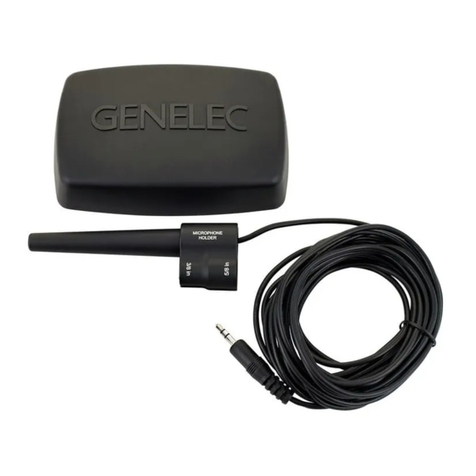
Genelec
Genelec GLM 2.0 User manual
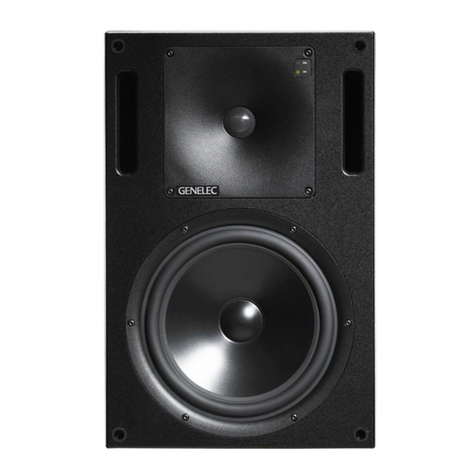
Genelec
Genelec 1032A User manual
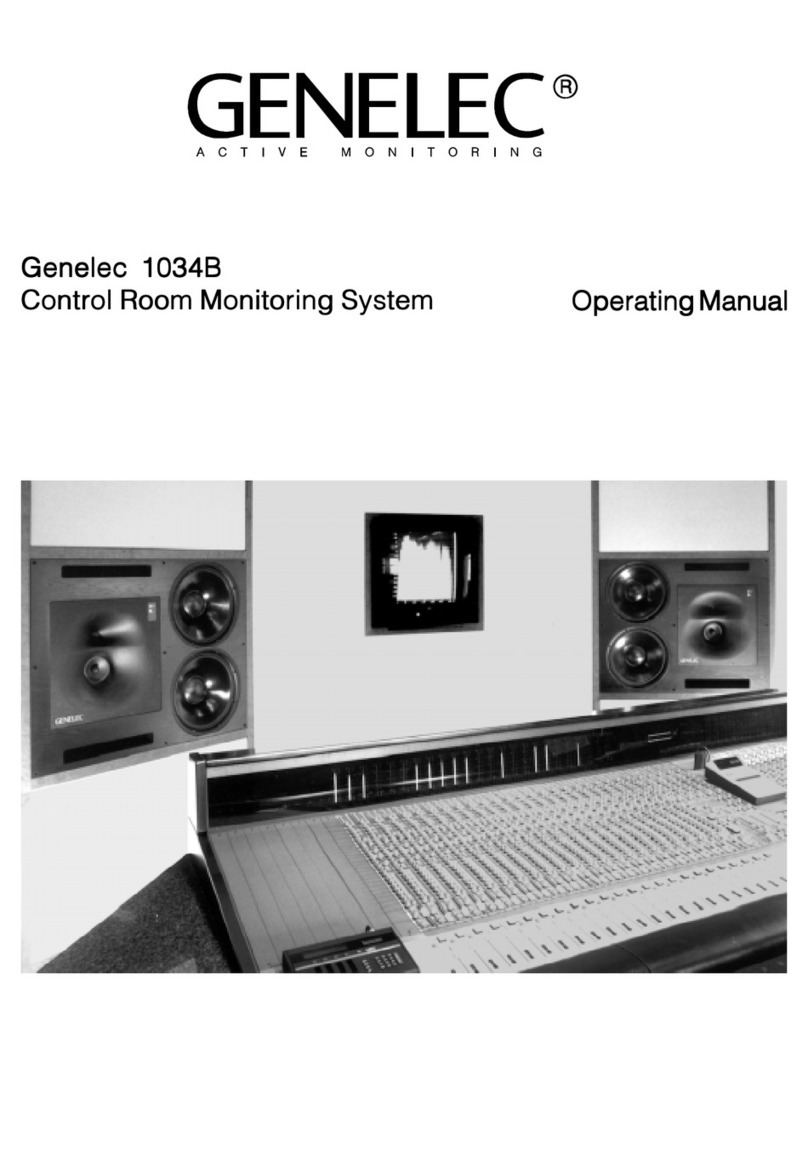
Genelec
Genelec 1034B User manual
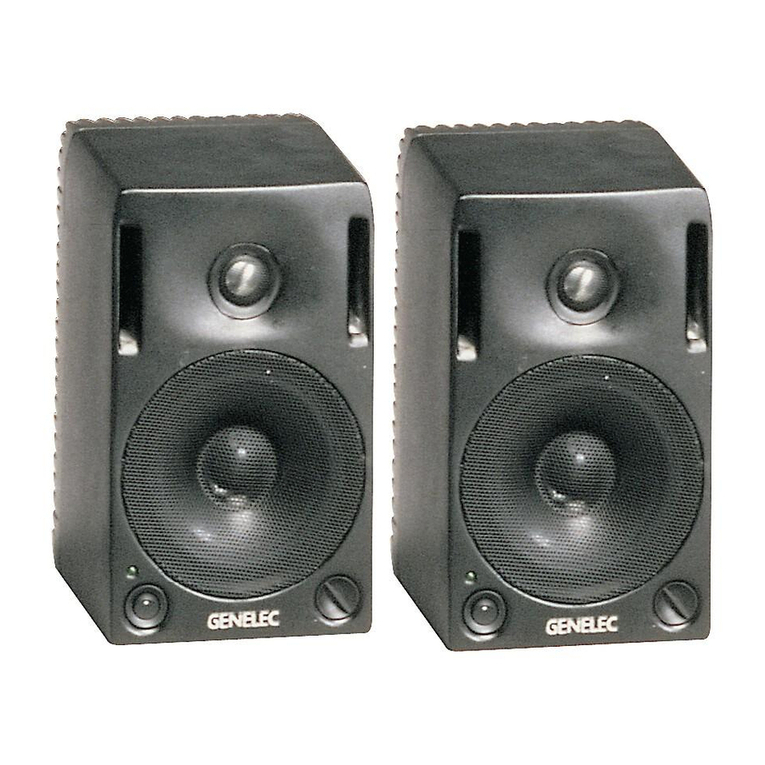
Genelec
Genelec 1029A User manual
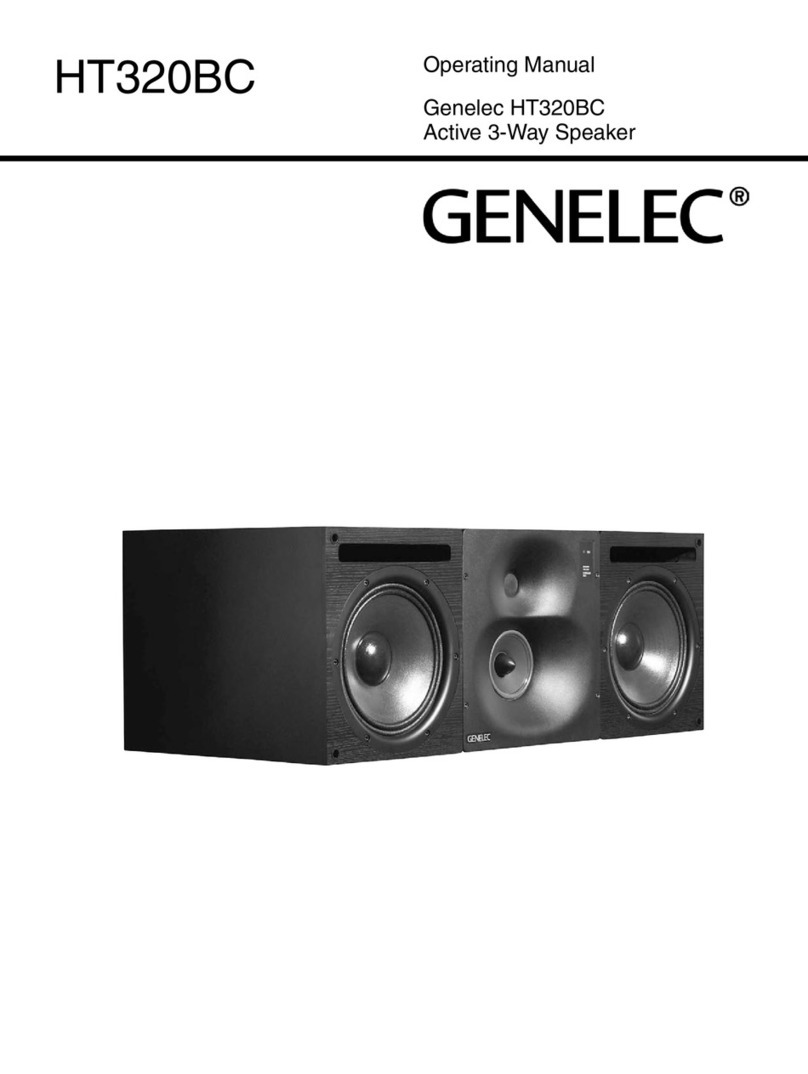
Genelec
Genelec HT320BC User manual

Genelec
Genelec 4436A User manual
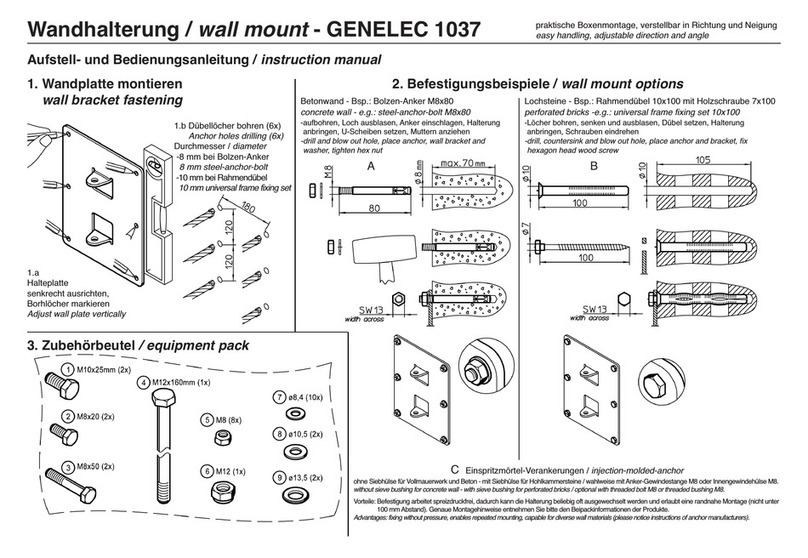
Genelec
Genelec 1037 User manual

Genelec
Genelec 1034BC User manual
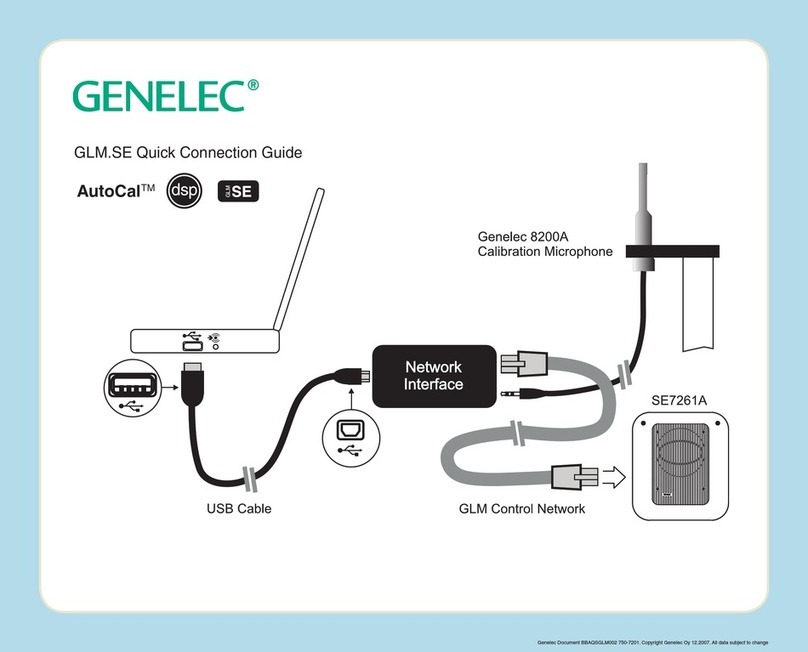
Genelec
Genelec GLM.SE Instruction Manual
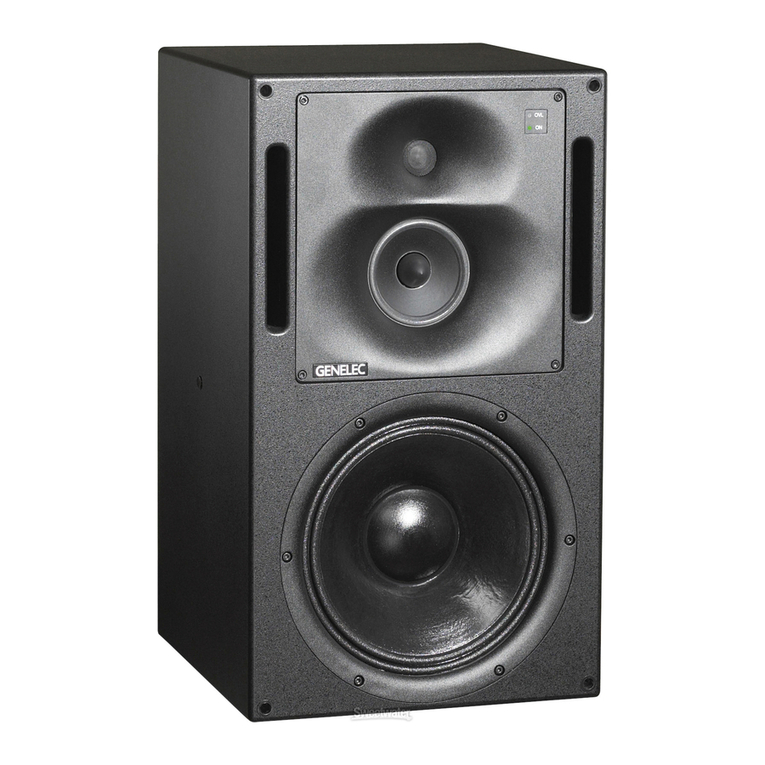
Genelec
Genelec 1037C User manual

Genelec
Genelec G Three User manual
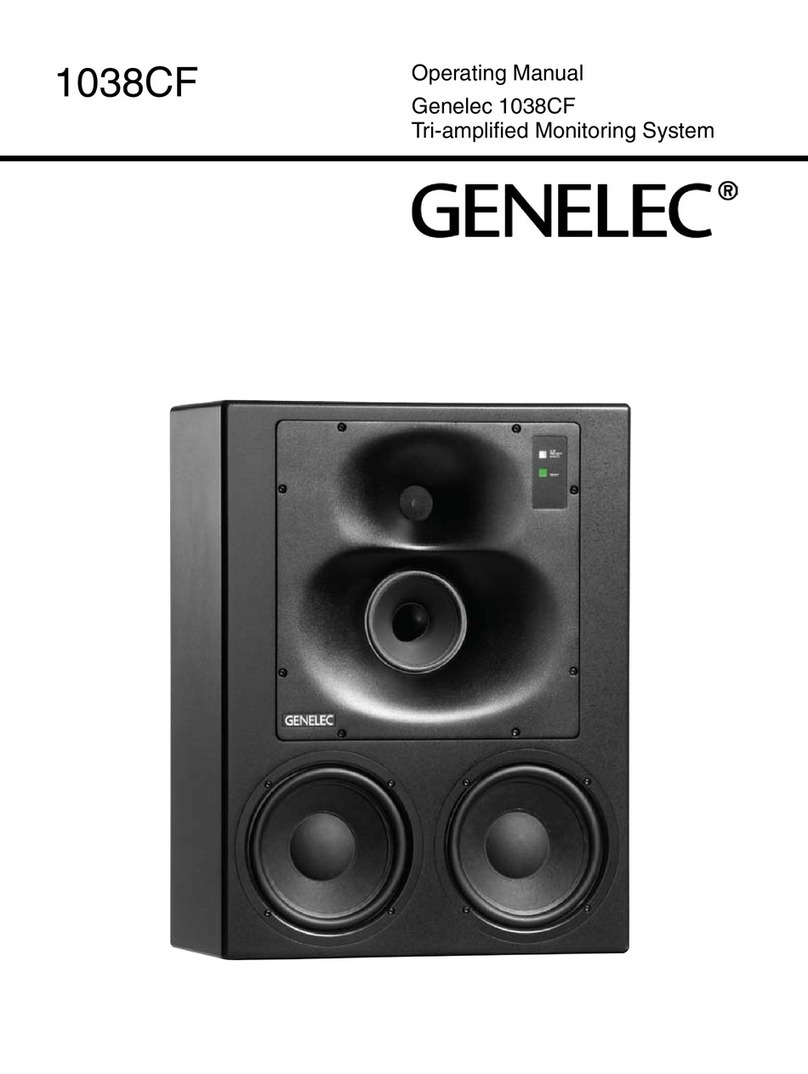
Genelec
Genelec 1038CF User manual
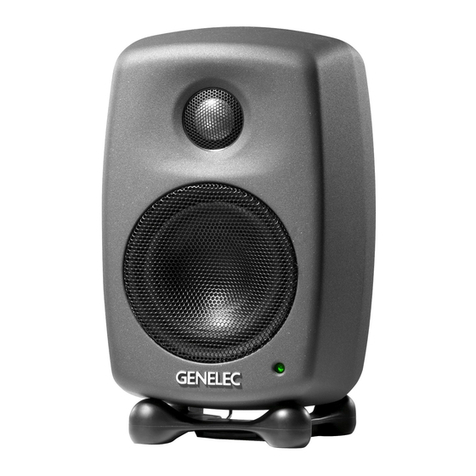
Genelec
Genelec 6010APM User manual
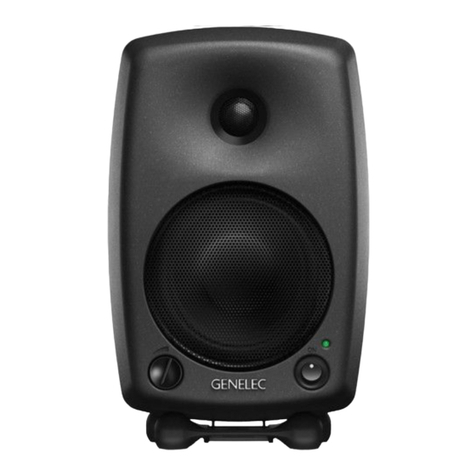
Genelec
Genelec 8030 User manual
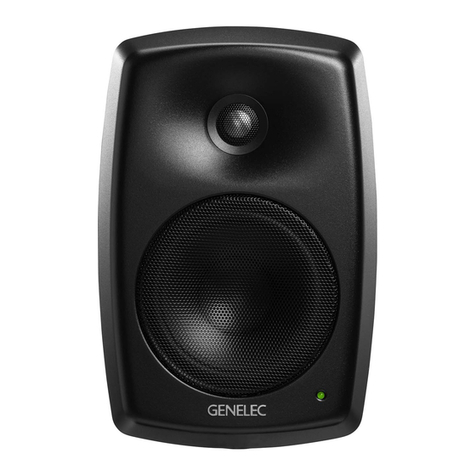
Genelec
Genelec Smart IP Manager User manual

Genelec
Genelec 1238CFM User manual
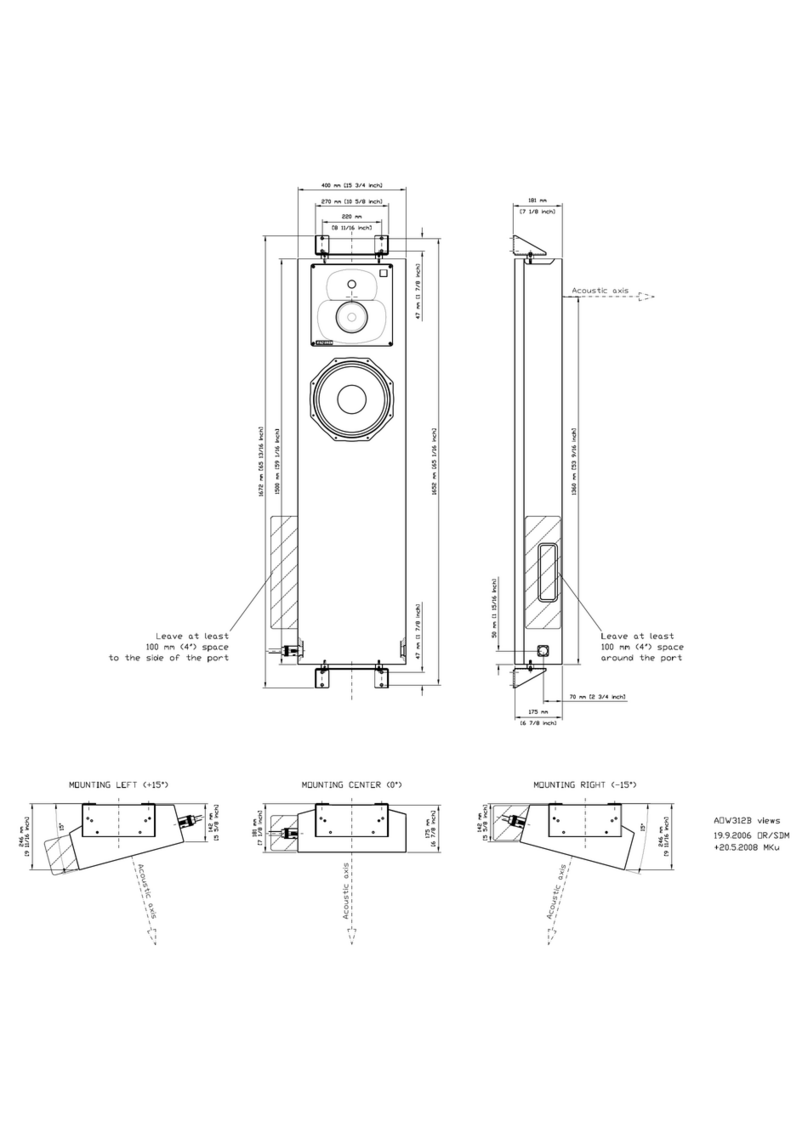
Genelec
Genelec AOW312 User guide
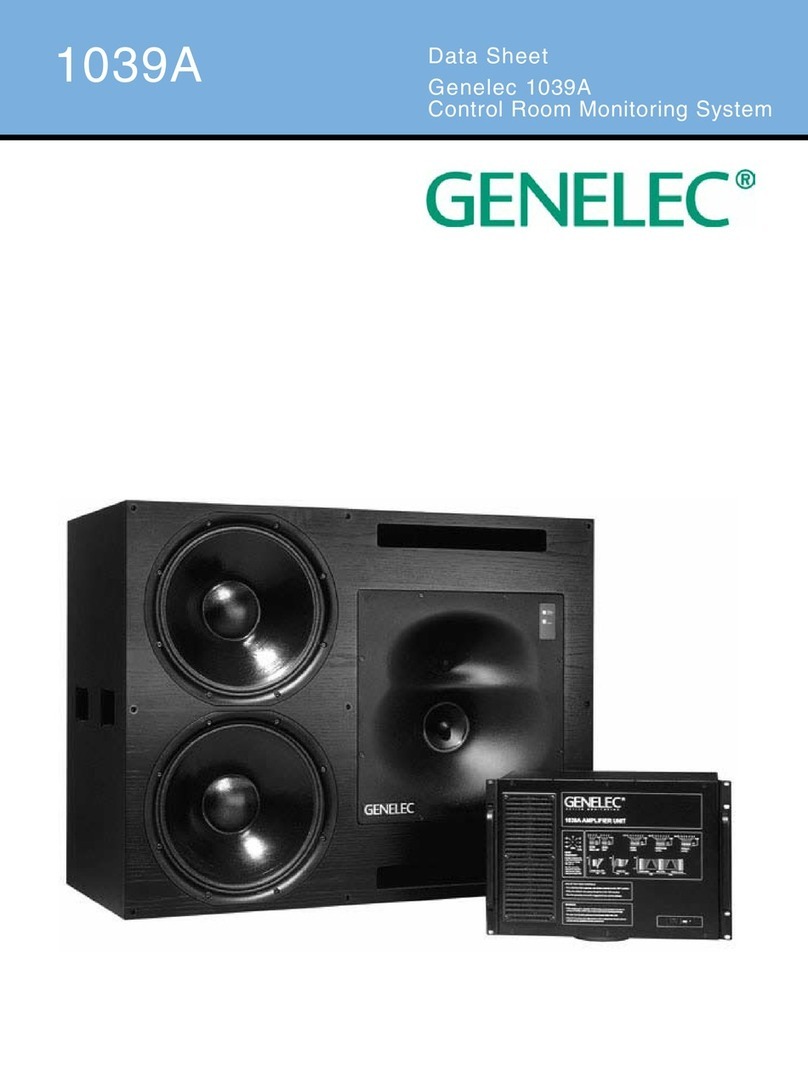
Genelec
Genelec 1039A User manual

Genelec
Genelec 4420A User manual
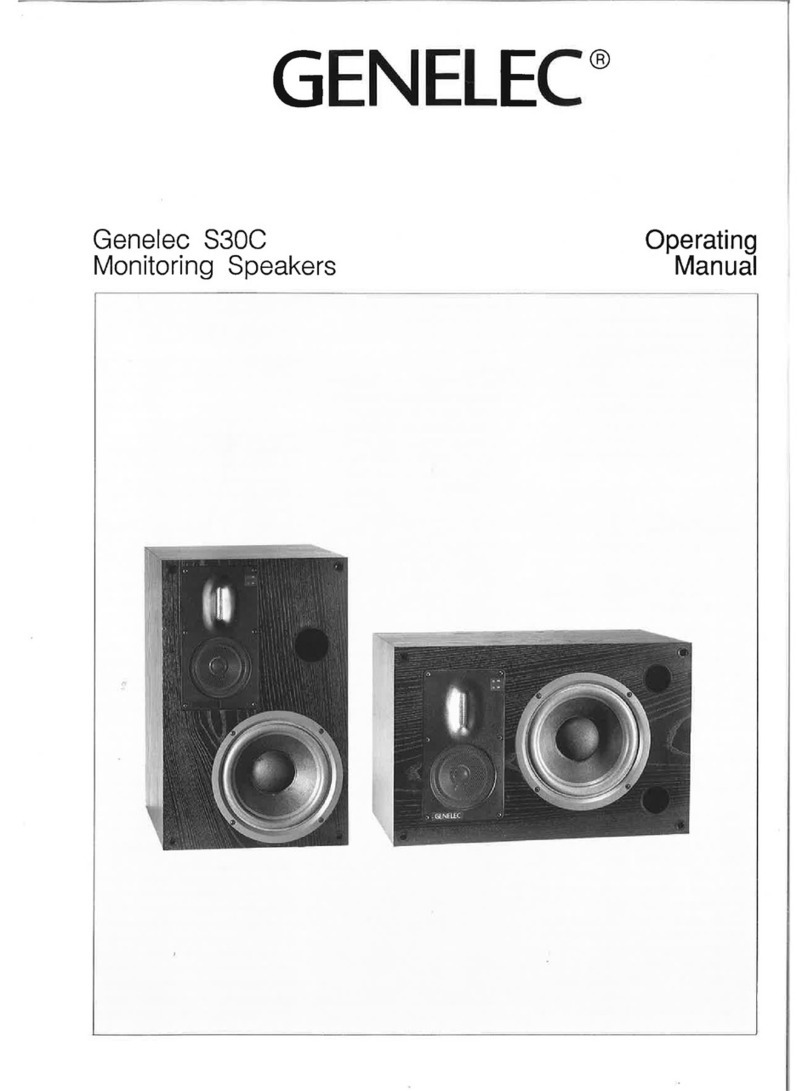
Genelec
Genelec S30C User manual
